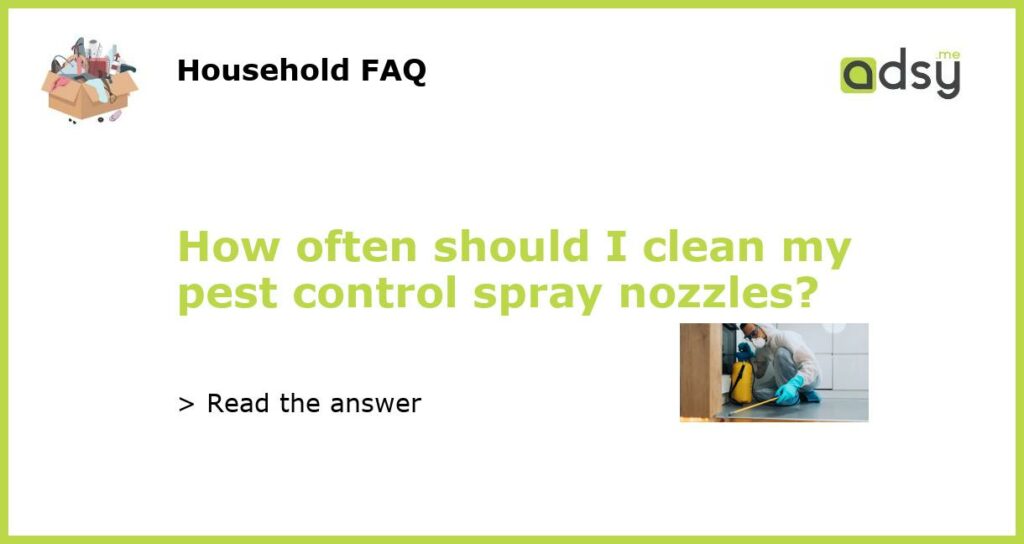Pest control is an essential part of maintaining a clean and healthy environment. However, it is important to regularly clean your pest control spray nozzles to ensure their effectiveness and longevity. In this article, we will discuss how often you should clean your pest control spray nozzles, the importance of regular cleaning, and the steps to follow for proper maintenance.
Why is it important to clean pest control spray nozzles regularly?
Regularly cleaning your pest control spray nozzles is crucial for several reasons. First and foremost, it helps to maintain the quality and effectiveness of the pesticide being sprayed. Over time, residue and buildup can accumulate on the nozzles, resulting in clogs or reduced spray coverage. This can significantly decrease the efficiency of the pesticide, leading to ineffectiveness in pest control.
Secondly, cleaning your spray nozzles regularly can help prevent any potential contamination. Pesticides have to be handled with care, as they can be harmful to humans, pets, and the environment. Any residue or buildup on the nozzles can contaminate the pesticide and lead to unintended exposure or environmental pollution.
Lastly, regular cleaning of your pest control spray nozzles can prolong their lifespan. Accumulated debris, such as dirt, chemicals, or pests, can cause corrosion or damage to the nozzles. By cleaning them regularly, you can prevent such issues and ensure that your nozzles last longer, saving you money in the long run.
How often should you clean your pest control spray nozzles?
The frequency of cleaning your pest control spray nozzles depends on various factors, such as the type of pesticide you use, the environment in which you operate, and the volume of spraying you do.
As a general guideline, it is recommended to clean your spray nozzles before and after each use. This ensures that any residue or buildup is removed before applying the pesticide and prevents any clogs or reduced effectiveness during usage. Cleaning before use also helps to avoid cross-contamination if you are switching between different types of pesticides.
In addition to pre and post-use cleaning, it is also advisable to perform a more thorough cleaning at regular intervals. Depending on your usage, this can range from once a month to once every few months. If you notice any signs of clogs, reduced spray coverage, or decreased performance, it is important to clean your nozzles immediately, even if it is before the scheduled cleaning.
Steps to clean your pest control spray nozzles
Cleaning your pest control spray nozzles is a relatively simple process that can be done with a few basic steps:
- Prepare a cleaning solution: Mix a solution of warm water and mild detergent in a bucket or container. This solution will be used to clean the nozzles.
- Remove the nozzles: Carefully unscrew the spray nozzles from the spray wand or handgun. Be cautious not to damage the threads or any other components.
- Soak the nozzles: Immerse the nozzles in the cleaning solution and let them soak for approximately 30 minutes. This will help loosen any residue or buildup on the nozzles.
- Scrub the nozzles: After soaking, use a soft-bristle brush or toothbrush to gently scrub the nozzles, removing any remaining debris. Pay attention to the tiny openings and ensure they are thoroughly cleaned.
- Rinse and dry the nozzles: Once the nozzles are clean, rinse them thoroughly with clean water to remove any soap residue. Dry them completely before reattaching them to the spray wand or handgun.
Cleaning your pest control spray nozzles regularly is crucial for maintaining their effectiveness, preventing contamination, and prolonging their lifespan. While pre and post-use cleaning is recommended, it is also important to perform a more thorough cleaning at regular intervals. By following the steps outlined in this article, you can ensure that your pest control spray nozzles remain in optimal condition, resulting in efficient and effective pest control operations.

